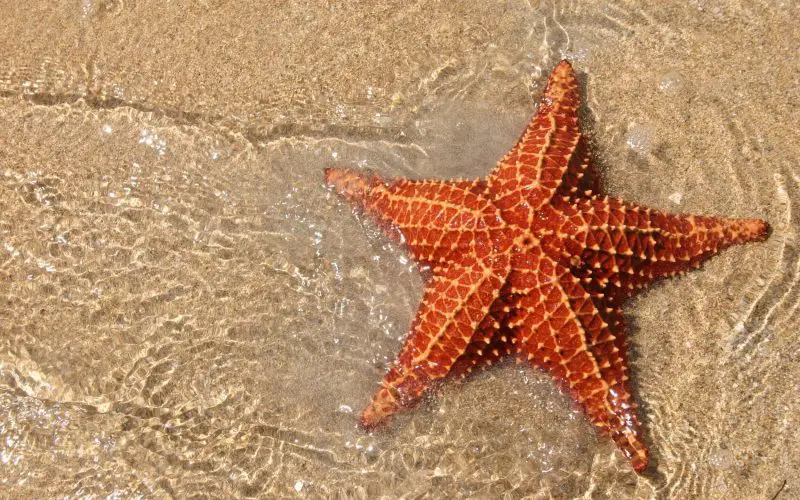Starfish, or sea stars, are among the ocean’s most iconic creatures—not just for their shape but for their astonishing ability to regrow lost limbs. Unlike most animals, starfish don’t just heal—they regenerate, rebuilding entire arms and sometimes even their whole bodies. This incredible power makes them a subject of fascination for marine biologists and a model for regenerative medicine. But how exactly do they do it?

What Happens When a Starfish Loses an Arm?
Natural Detachment and Injury
In the silent, slow-paced world of the seafloor, danger lurks in the form of crabs, fish, sea otters, and even aggressive starfish. When a starfish is attacked, its survival doesn’t depend on speed—it depends on sacrifice. With an ancient survival strategy known as autotomy, some starfish have evolved the ability to intentionally shed a limb.
This isn’t a random accident. It’s a calculated move. The starfish severs its own connective tissues and muscles at a predetermined break point near the base of the arm. The detached limb often continues to wriggle for several minutes, distracting the predator long enough for the starfish to crawl to safety. In that moment, it chooses to give up a part to save the whole—an evolutionary masterstroke.
But not all arm loss is voluntary. Sometimes, accidents from rough currents or fights over food can cause a limb to snap off. Regardless of the cause, what happens next is nothing short of biological magic.
Healing Begins Instantly
The moment an arm is lost, the clock starts ticking. Starfish do not wait hours or days to start healing—they begin within minutes. Cells around the injury site spring into action. Specialized cells flood the wound, rapidly closing it to block invading bacteria or parasites from entering the starfish’s soft internal tissues.
Beneath the hardened skin, immune cells activate while structural cells begin reorganizing. Old tissue is broken down, signaling molecules are released, and a complex web of communication begins between thousands of microscopic players. It’s as if the starfish body knows exactly what needs to happen—and wastes no time setting the stage for regeneration.
This early healing phase is not just a patch-up job. It’s the foundation for something far more extraordinary: the growth of a new, fully functional arm, complete with nerves, muscles, skeleton, and tube feet. The process has begun—and the ocean now watches as life reassembles itself, one cell at a time.
The Cellular Secrets of Regeneration
Pluripotent Cells and Tissue Remodeling
Beneath the skin of a wounded starfish, a silent cellular revolution begins. At the site where the arm was torn away, a specialized group of cells called pluripotent cells rushes in—cells so versatile that they hold the potential to become almost any type of tissue the body needs. They are nature’s version of blank slates.
As these cells accumulate at the wound site, they don’t merely cover the injury—they transform it. The cells rapidly begin to divide, forming a small mound of living tissue known as a blastema. This mass is the biological blueprint for the new arm, holding within it the instructions to reconstruct everything from muscles and bones to nerves and skin.
What’s remarkable is the level of precision involved. Unlike scar tissue in humans, which merely seals damage, the starfish blastema is like a factory of rebirth. It doesn’t just heal—it rebuilds, layer by layer, with the goal of restoring full form and function.
Genes that Guide Regrowth
Behind this cellular ballet is a powerful set of genetic instructions. As the blastema forms, hundreds of genes flicker on like lights in a city at dusk. These regeneration genes are responsible for telling each cell what to become, where to go, and when to stop growing.
Some of these genes are surprisingly familiar. Scientists have found that many of the molecular pathways activated in starfish regeneration are also present in vertebrates, including humans. Genes that control cell proliferation, differentiation, and spatial patterning are switched into overdrive, orchestrating the formation of the new limb with stunning accuracy.
These discoveries have profound implications. If nature has written the code for regeneration in starfish, and if that code partially overlaps with our own, then unlocking its secrets might one day allow us to repair spinal cords, regrow limbs, or regenerate damaged organs. For now, the starfish remains both a marvel of evolution and a beacon of hope for future medicine.
How Long Does It Take for a Starfish to Regrow an Arm?
Timeframes Vary by Species
Regrowing a lost arm is no overnight miracle. For starfish, regeneration is a slow, deliberate process—one that may take several months to more than a year, depending on a variety of biological and environmental factors.
Some species, like the striking Blue Linckia (Linckia laevigata), are known for their regenerative speed, often regrowing entire arms in just a few months under optimal conditions. These tropical reef dwellers thrive in warm, nutrient-rich waters that fuel the regeneration engine. In contrast, deep-sea species or those inhabiting cold, oxygen-poor environments may take much longer—sometimes well over a year—to complete the process.
Regeneration is not just a one-size-fits-all phenomenon. It unfolds on nature’s timetable, shaped by the starfish’s lifestyle, habitat, and internal energy reserves.
Factors That Influence Regeneration Speed
The pace of regeneration can differ dramatically, even within the same species. A variety of factors silently shape the timeline:
Nutrition:
Just like construction requires building materials, regrowth requires fuel. Well-nourished starfish, rich in stored energy from a healthy diet of mussels, clams, or algae, are able to regenerate faster. In contrast, a starfish struggling to find food may pause or delay the process.
Environmental Conditions:
The surrounding ocean plays a crucial role. Warmer temperatures tend to accelerate cell division and tissue formation, while colder waters slow everything down. Similarly, salinity and oxygen levels affect how efficiently a starfish’s cells function—too much or too little can stall regeneration.
Size and Location of the Injury:
A clean break at the tip of the arm may take only a few months to heal. But if an arm is severed near the base, where it connects to the central body disk, the task is far greater. In such cases, the starfish must reconstruct not only tissues, but complex internal structures such as nerves, water canals, and skeletal plates—a biological feat that takes much longer.
Can Starfish Regrow an Entire Body?
A Rare but Real Phenomenon
As astonishing as it is for a starfish to regrow a lost arm, there’s an even more jaw-dropping possibility hidden in the biology of certain species: the power to regrow an entire body from just a single arm. This phenomenon, though rare, has been observed in a handful of starfish, most notably in species like the Linckia.
But there’s a catch—it’s not just any arm that can pull off this feat. The arm must retain a portion of the central disc, the vital hub that houses key organs and the central nerve ring. If that fragment survives detachment, the remaining tissue can, over time, regenerate the missing arms, organs, and bodily structures until a complete, fully functional starfish reemerges.
This process, known as clonal fragmentation, is one of the most extreme examples of regeneration in the animal kingdom. It blurs the line between healing and reproduction, transforming a single severed limb into a brand-new organism. In the vast, unpredictable ocean, this ability can mean the difference between extinction and expansion.
Regeneration vs. Reproduction
At first glance, the idea of an arm growing into a whole new starfish might sound like asexual reproduction—and in some ways, it mimics that. But technically, this is still regeneration, not reproduction, because it stems from an injury or separation rather than a reproductive event.
Still, the evolutionary advantages are undeniable. In regions where predators frequently maim or dismember starfish, the ability to regenerate from fragments allows populations to bounce back quickly. Detached arms drifting on ocean currents may wash up in distant areas, settle, and slowly rebuild—allowing the species to colonize new environments without ever producing offspring in the traditional sense.
It’s a stunning example of nature’s resourcefulness: when broken apart, a starfish doesn’t just survive—it replicates. Through regeneration, these creatures defy destruction and turn loss into renewal.
Why Starfish Regeneration Matters
Ecological Importance
Far from being just passive decorations on the seafloor, starfish play an active and crucial role in marine ecosystems. Many species are keystone predators, meaning their presence directly influences the structure and health of entire communities. Their preferred prey—mussels, clams, barnacles, and other slow-moving invertebrates—can quickly dominate habitats if left unchecked.
But life on the ocean floor is anything but safe. Starfish face a constant barrage of threats: predators, storms, fishing gear, and environmental changes. Without their extraordinary power of regeneration, they would struggle to survive long enough to fulfill their ecological roles.
Regeneration is their lifeline. It allows them not only to survive trauma but to recover fully and return to their predatory routines. This resilience helps keep populations of prey species in check, preventing overgrowth and maintaining the delicate balance of biodiversity on coral reefs, tidal flats, and rocky shorelines.
Without starfish, some ecosystems could spiral into imbalance, leading to loss of diversity and structural collapse. Their ability to regenerate ensures they stay in the fight—even after losing limbs.
Medical Inspiration
The wonder of starfish regeneration goes far beyond the ocean—it’s captivating scientists in laboratories around the world. The very genes and cellular mechanisms that allow a starfish to rebuild a lost arm may hold the key to solving some of modern medicine’s greatest challenges.
Researchers have identified genetic pathways in starfish that are strikingly similar to those found in humans. These pathways control processes like wound healing, tissue regeneration, and cellular differentiation—all vital components in treating conditions such as spinal cord injuries, lost limbs, nerve damage, and even organ failure.
Unlike mammals, which form scar tissue after injury, starfish regenerate true functional structures—complete with muscles, nerves, and vascular systems. Understanding how they avoid scarring and instead regenerate seamlessly is of enormous interest to regenerative medicine and tissue engineering.
By studying starfish, scientists are asking bold questions:
Could humans one day regrow a severed finger or repair a damaged spinal cord? Could we stimulate our own regenerative genes to heal the body from within?
Though we are still far from those breakthroughs, starfish offer a living blueprint—a model of what full-body regeneration looks like when it works to perfection. From ocean floors to research labs, these humble sea creatures may help reshape the future of medicine.
Differences Among Starfish Species
Not All Starfish Regrow Equally
With over 1,900 recognized species of starfish inhabiting the world’s oceans, it’s no surprise that their regenerative abilities vary widely. Some species are true masters of regeneration, while others are far more limited.
At the forefront of this biological marvel is the Blue Linckia (Linckia laevigata), a bright-blue tropical starfish known for its almost mythical regenerative capacity. In the right conditions, even a single arm containing a small piece of its central disc can regenerate into a full starfish—essentially creating a genetic clone of the original.
On the other end of the spectrum are species that can only heal small injuries or regenerate the very tips of damaged arms. These species may not rely on regeneration as a survival strategy, instead focusing their energy on camouflage, tougher skin, or other forms of defense. The degree of regeneration appears closely tied to the starfish’s lifestyle, evolutionary history, and habitat.
Deep-Sea vs. Shallow-Water Species
One of the most striking differences in regenerative ability is found between shallow-water and deep-sea starfish. Those living in shallow tropical or temperate waters—where sunlight, warmth, and food are more abundant—tend to regenerate faster and more frequently. These environments often expose starfish to predators, wave action, and environmental fluctuations, making quick recovery a necessity.
By contrast, deep-sea starfish lead slower, more conservative lives. Dwelling thousands of meters below the surface in icy, pitch-black waters, they have lower metabolic rates, slower growth, and fewer immediate threats. In these conditions, regeneration still occurs—but it’s often sluggish and less extensive, taking much longer than in their shallow-water cousins.
These differences are more than curiosities—they reveal how regeneration is shaped by ecological pressures. Where life moves fast and danger is constant, regeneration is a rapid, essential tool. Where life is slower and more stable, starfish can afford to take their time—or rely less on limb regrowth altogether.
The Evolutionary Advantage of Regrowing Arms
Defense and Survival
In the underwater world where speed is not an option and threats come from all directions, the ability to sacrifice a limb becomes a powerful tool for survival. For the starfish, losing an arm isn’t a fatal blow—it’s a calculated escape plan. When attacked by a predator like a fish, crab, or octopus, the starfish can drop a writhing arm to distract the attacker, buying precious time to slip away along the seabed.
This strategy, known as autotomy, does more than just protect the starfish in the moment—it enhances its chances of long-term survival. Over weeks or months, the missing limb regrows completely, often indistinguishable from the original. Unlike animals that suffer permanent loss from injury, the starfish suffers no lasting disadvantage. This capacity effectively reduces the cost of predation, ensuring the starfish can continue to feed, move, reproduce, and interact with its environment as if nothing had happened.
In the grand theater of natural selection, this trait offers a distinct evolutionary edge. Species that can recover from severe injuries have a better chance of surviving and reproducing, especially in harsh or competitive ecosystems. Regeneration, in this light, isn’t just a healing trick—it’s a winning strategy.
Reproductive Independence
For certain starfish species, regeneration offers an even greater evolutionary payoff: a path to reproduction without a partner. In rare but remarkable cases, a single severed arm containing a piece of the central disc can regenerate into an entirely new individual. This process, while technically still regeneration rather than reproduction, functions as a form of clonal replication.
In environments where mates are scarce—such as deep-sea habitats, isolated reef patches, or after population crashes—this ability becomes a game-changer. A single surviving limb can restart a population, spreading genetic copies across a region without any need for fertilization.
This form of reproductive independence allows starfish to persist in places where other animals might go extinct. It provides a backup plan for survival and dispersal, giving certain species an advantage in colonizing new areas and rebounding from disasters.
Ultimately, the ability to regenerate arms—and in some cases, entire bodies—is more than a biological curiosity. It’s a finely honed adaptation shaped by millions of years of evolution, one that ensures starfish remain resilient, adaptable, and remarkably successful across Earth’s oceans.
Conclusion: Nature’s Master of Regrowth
The ability of starfish to regrow arms—and in some cases, entire bodies—is one of nature’s most spectacular displays of biological resilience. It reflects a finely tuned balance of cellular plasticity, genetic precision, and ecological adaptation. As science continues to uncover the molecular pathways behind this phenomenon, starfish may become the unlikely heroes in the quest to unlock regenerative medicine for humans.






